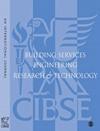Optimization of chiller sequencing control for district cooling system at the Hong Kong-Zhuhai-Macao Bridge Hong Kong Port
IF 1.8
4区 工程技术
Q3 CONSTRUCTION & BUILDING TECHNOLOGY
Building Services Engineering Research & Technology
Pub Date : 2022-04-15
DOI:10.1177/01436244221088778
引用次数: 0
Abstract
To mitigate the climate change issue, the Government of the Hong Kong Special Administrative Region (HKSAR) proposed the “Hong Kong Climate Change Plan 2030+” with an ambitious goal of reducing the carbon intensity to 65%–70% below 2005 levels by 2030. To achieve this target, the HKSAR Government has developed two District Cooling Systems (DCS) to promote the use of district energy system, enhancing the overall energy efficiency for cooling purpose. One of the government-owned DCSs is located at the Hong Kong-Zhuhai-Macao Bridge Hong Kong Port (HZMB-HKP), producing a total design cooling capacity of 24.16 MW to passenger clearance building and ancillary buildings there. This paper demonstrates how the DCS at HZMB-HKP could enhance overall energy efficiency for cooling purpose, through proper chiller sequencing control, and reduce CO2 emission significantly. An optimal seasonal chiller operation mode is also suggested to be adopted at the DCS at HZMB-HKP from cost-effectiveness perspective. Practical application: District Cooling Systems are considered as a promising solution to alleviate the climate change issue. An optimized chiller sequencing control strategy of DCS can effectively reduce overall cooling energy consumption, so as to achieve carbon neutrality. This paper outlines a case study on a cost-effective operational control strategy of the DCS at HZMB-HKP. The analysis of both the theoretical and practical sequencing control strategy can be taken as a reference for DCS development in the future.香港港珠海-马槽大桥区域制冷系统冷水机组顺序控制的优化
为了缓解气候变化问题,香港特别行政区政府提出了“香港2030年气候变化计划+”,目标是到2030年将碳排放强度降至2005年水平以下65%至70%。为达致这个目标,特区政府发展了两套区域供冷系统,以推广使用区域能源系统,从而提高整体供冷能源的效率。其中一个政府拥有的DCS位于香港港珠海大桥(HZMB-HKP),为那里的旅客清关大楼和附属建筑提供24.16MW的总设计制冷能力。本文展示了HZMB-HKP的DCS如何通过适当的冷却器顺序控制来提高冷却目的的整体能源效率,并显著减少CO2排放。从成本效益的角度来看,还建议HZMB-HKP的DCS采用最佳季节性冷水机组运行模式。实际应用:区域冷却系统被认为是缓解气候变化问题的一个有前途的解决方案。采用DCS优化的冷水机组顺序控制策略,可有效降低整体制冷能耗,实现碳中和。本文概述了HZMB-HKP分布式控制系统成本效益运行控制策略的案例研究。从理论和实践两方面分析了顺序控制策略,可为DCS的未来发展提供参考。
本文章由计算机程序翻译,如有差异,请以英文原文为准。
求助全文
约1分钟内获得全文
求助全文
来源期刊

Building Services Engineering Research & Technology
工程技术-结构与建筑技术
CiteScore
4.30
自引率
5.90%
发文量
38
审稿时长
>12 weeks
期刊介绍:
Building Services Engineering Research & Technology is one of the foremost, international peer reviewed journals that publishes the highest quality original research relevant to today’s Built Environment. Published in conjunction with CIBSE, this impressive journal reports on the latest research providing you with an invaluable guide to recent developments in the field.
 求助内容:
求助内容: 应助结果提醒方式:
应助结果提醒方式:


